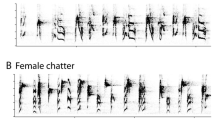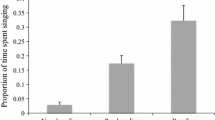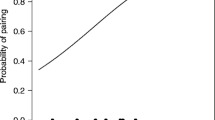Abstract
The widespread occurrence of extra-pair paternity (EPP) in birds adds rich complexity to our understanding of sexual selection and mating system evolution. Extra-pair matings are typically cryptic so for most species, we lack the detailed behavioral observations needed to fully determine whether both sexes benefit from EPP and when trait correlations with EPP are found, whether they reflect female choice or male intrasexual competition. Here we examine behavioral and morphological correlates of EPP in the lark bunting (Calamospiza melanocorys), a grassland songbird where EPP-seeking behaviors of males are unusually overt and conspicuous. Males sought EPP by closely following receptive pairs, often in groups. Virtually all observed extra-pair copulation attempts involved male aggression, were resisted by females, and larger females had a lower rate of extra-pair paternity in their nests. Male plumage traits predicted both male effort in seeking EPP (number of mating groups joined) and fitness gained through EPP; these same male traits have previously been linked to male-male competition but were not linked to consistent mate choice in lark buntings. There was no trade-off between investment in seeking EPP and fitness at a male’s own nest, indicating that fitness from EPP is likely a potent driver of sexual selection in lark buntings, one that may not entirely be driven by female fitness interests.






Similar content being viewed by others
Data and code availability
The code and data sets required to replicate these analyses are available in the Dryad Digital Repository (https://doi.org/10.7291/D1B696).
References
Akçay E, Roughgarden J (2007) Extra-pair paternity in birds: review of the genetic benefits. Evol Ecol Res 9:855–868
Arnold KE, Owens IPF (2002) Extra-pair paternity and egg dumping in birds: life history, parental care and the risk of retaliation. Proc R Soc Lond B 269:1263–1269. https://doi.org/10.1098/rspb.2002.2013
Arnqvist G, Kirkpatrick M (2005) The evolution of infidelity in socially monogamous passerines: the strength of direct and indirect selection on extrapair copulation behavior in females. Am Nat 165:S26-37
Barna JB (2004) Variability in male parental care in birds: factors shaping male incubation in the lark bunting, a species under strong sexual selection. MS thesis, University of California, Santa Cruz
Bateman AJ (1948) Intra-sexual selection in Drosophila. Heredity 2:349–368
Bates D, Mächler M, Bolker B, Walker S (2015) Fitting linear mixed-effects models using lme4. J Stat Softw 67:1–48. https://doi.org/10.18637/jss.v067.i01
Berg EC (2005) Parentage and reproductive success in the white-throated magpie-jay, Calocitta formosa, a cooperative breeder with female helpers. Anim Behav 70:375–385
Biagolini-Jr C, Westneat DF, Francisco MR (2017) Does habitat structural complexity influence the frequency of extra-pair paternity in birds? Behav Ecol Sociobiol 71:1–8
Birkhead TR, Møller AP (1992) Sperm competition in birds. Academic Press, San Diego, CA, Evolutionary causes and consequences
Brekke P, Cassey P, Ariani C, Ewen JG (2013) Evolution of extreme-mating behaviour: patterns of extrapair paternity in a species with forced extrapair copulation. Behav Ecol Sociobiol 67:963–972
Briskie JV, Montgomerie R (1997) Sexual selection and the intromittent organ of birds. J Avian Biol 28:73–86
Brouwer L, Griffith SC (2019) Extra-pair paternity in birds. Mol Ecol 28:4864–4882. https://doi.org/10.1111/mec.15259
Castro I, Minot EO, Fordham RA, Birkhead TR (1996) Polygynandry, face-to-face copulation and sperm competition in the Hihi Notiomystis cincta (Aves: Meliphagidae). Ibis 138:765–771
Chaine AS, Lyon BE (2008a) Adaptive plasticity in female mate choice dampens sexual selection on male ornaments in the lark bunting. Science 319:459–462. https://doi.org/10.1126/science.1149167
Chaine AS, Lyon BE (2008b) Intrasexual selection on multiple plumage ornaments in the lark bunting. Anim Behav 76:657–667. https://doi.org/10.1016/j.anbehav.2008.03.014
Chaine AS, Lyon BE (2015) Signal architecture: temporal variability and individual consistency of multiple sexually selected signals. Funct Ecol 29:1178–1188. https://doi.org/10.1111/1365-2435.12410
Chaine AS, Montgomerie R, Lyon BE (2015) Sexual conflict arising from extrapair matings in birds. Cold Spring Harb Perspect Biol 7:a017590. https://doi.org/10.1101/cshperspect.a017590
Chaine AS (2006) The evolution of multiple sexual signals in a passerine: trait structure and selection in a dynamic world. Dissertation, University of California, Santa Cruz
Davies NB (1989) Sexual conflict and the polygamy threshold. Anim Behav 38:226–234. https://doi.org/10.1016/S0003-3472(89)80085-5
Dickinson JL (2001) Extrapair copulations in western bluebirds (Sialia mexicana): female receptivity favors older males. Behav Ecol Sociobiol 50:423–429
Double M, Cockburn A (2000) Pre–dawn infidelity: females control extra-pair mating in superb fairy–wrens. Proc R Soc Lond B 267:465–470
Dunn PO, Cockburn A (1999) Extrapair mate choice and honest signaling in cooperatively breeding superb fairy-wrens. Evolution 53:938–946. https://doi.org/10.2307/2640733
Eliassen S, Kokko H (2008) Current analyses do not resolve whether extra-pair paternity is male or female driven. Behav Ecol Sociobiol 62:1795–1804. https://doi.org/10.1007/s00265-008-0608-2
Emlen ST, Oring LW (1977) Ecology, sexual selection, and the evolution of mating systems. Science 197:215–223
Ferree ED, Dickinson J, Rendell W, Stern C, Porter S (2010) Hatching order explains an extrapair chick advantage in western bluebirds. Behav Ecol 21:802–807
Freckleton RP (2002) On the misuse of residuals in ecology: regression of residuals vs. multiple regression. J Anim Ecol 71:542–545
Fry JD (2022) A reexamination of theoretical arguments that indirect selection on mate preference is likely to be weaker than direct selection. Evol Lett 6:110–117. https://doi.org/10.1002/evl3.276
Gowaty PA, Buschhaus N (1998) Ultimate causation of aggressive and forced copulation in birds: female resistance, the CODE hypothesis, and social monogamy. Am Zool 38:207–225
Griffith SC (2007) The evolution of infidelity in socially monogamous passerines: neglected components of direct and indirect selection. Am Nat 169:274–281
Griffith SC, Owens IPF, Thuman KA (2002) Extra pair paternity in birds: a review of interspecific variation and adaptive function. Mol Ecol 11:2195–2212
Hasselquist D, Bensch S, von Schantz T (1996) Correlation between male song repertoire, extra-pair paternity and offspring survival in the great reed warbler. Nature 381:229–232
Hoi H (1997) Assessment of the quality of copulation partners in the monogamous bearded tit. Anim Behav 53:277–286
Jennions MD, Petrie M (2000) Why do females mate multiply? A review of the genetic benefits. Biol J Linn Soc 75:21–64
Kempenaers B, Schlicht E (2010) Extra-pair behaviour. In: Kappeler P (ed) Animal behaviour: evolution and mechanisms. Springer, Berlin, pp 359–411
Kempenaers B, Verheyen GR, Dhondi AA (1997) Extrapair paternity in the blue tit (Parus caeruleus): female choice, male characteristics, and offspring quality. Behav Ecol 8:481–492
Lack DL (1968) Ecological adaptations for breeding in birds. Methuen, London
Lessells CM, Boag PT (1987) Unrepeatable Repeatabilities: a Common Mistake Auk 104:116–121. https://doi.org/10.2307/4087240
Low M (2005) Female resistance and male force: context and patterns of copulation in the New Zealand stitchbird Notiomystis cincta. J Avian Biol 36:436–448
Magrath MJL, Elgar MA (1997) Paternal care declines with increased opportunity for extra–pair matings in fairy martins. Proc R Soc Lond B 264:1731–1736
Magrath MJL, Vedder O, van der Velde M, Komdeur J (2009) Maternal effects contribute to the superior performance of extra-pair offspring. Curr Biol 19:792–797
Marshall TC, Slate J, Kruuk LEB, Pemberton JM (1998) Statistical confidence for likelihood-based paternity inference in natural populations. Mol Ecol 7:639–655
McKinney F, Derrickson SR, Mineau P (1983) Forced copulation in waterfowl. Behaviour 86:250–293
Neudorf DL, Stutchbury BJM, Piper WH (1997) Covert extraterritorial behavior of female hooded warblers. Behav Ecol 8:595–600
Orians GH (1969) On the evolution of mating systems in birds and mammals. Am Nat 103:589–603
Pitelka FA, Holmes RT, MacLean SF Jr (1974) Ecology and evolution of social organization in arctic sandpipers. Am Zool 14:185–204
Pleszczynska WK (1978) Microgeographic prediction of polygyny in the lark bunting. Science 201:935–937
Pleszczynska W, Hansell RIC (1980) Polygyny and decision theory: testing of a model in lark buntings (Calamospiza melanocorys). Am Nat 116:821–830
Pryke SR, Rollins LA, Griffith SC (2010) Females use multiple mating and genetically loaded sperm competition to target compatible genes. Science 67:964–967
R Developmental Core Team (2020) R: a language and environment for statistical computing. R Foundation for Statistical Computing, Vienna, Austria, http://www.R-project.org
Richardson DS, Jury FL, Blaakmeer K, Komdeur J, Burke T (2001) Parentage assignment and extra-group paternity in a cooperative breeder: the Seychelles warbler (Acrocephalus sechellensis). Mol Ecol 10:2263–2273
Schlicht E, Kempenaers B (2011) Extra-pair paternity and sexual selection. In: Inoue-Murayama M, Kawamura S, Weiss A (eds) From genes to animal behavior: social structures, personalities, communication by color. Springer, Berlin, pp 35–65
Seutin G, White BN, Boag PT (1991) Preservation of avian blood and tissue samples for DNA analyses. Can J Zool 69:82–90
Shane TG (2020) Lark Bunting (Calamospiza melanocorys), version 1.0. In: Poole AF, Gill FB (eds) Birds of the World . Cornell Lab of Ornithology, Ithaca
Sherman PW, Morton ML (1988) Extra-pair fertilizations in mountain white-crowned sparrows. Behav Ecol Sociobiol 22:413–420. https://doi.org/10.1007/BF00294979
Stoffel MA, Nakagawa S, Schielzeth H (2021) partR2: partitioning R2 in generalized linear mixed models. PeerJ 9:e11414. https://doi.org/10.7717/peerj.11414
Stutchbury BJM (1998) Female mate choice of extra-pair males: breeding synchrony is important. Behav Ecol Sociobiol 43:213–215. https://doi.org/10.1007/s002650050483
Thusius KJ, Peterson KA, Dunn PO, Whittingham LA (2001) Male mask size is correlated with mating success in the common yellowthroat. Anim Behav 62:435–446. https://doi.org/10.1006/anbe.2001.1758
Townsend AK (2009) Extrapair copulations predict extrapair fertilizations in the American crow. Condor 111:387–392
Townsend AK, Clark AB, McGowan KJ (2010) Direct benefits and genetic costs of extrapair paternity for female American crows (Corvus brachyrhynchos). Am Nat 175:E1–E9
Trivers RL (1972) Parental investment and sexual selection. In: Campbell BG (ed) Sexual selection and the descent of man, 1871–1971. Aldine, Chicago, pp 136–179
Verner J, Willson MF (1966) The influence of habitats on mating systems of North American passerine birds. Ecology 47:143–147
Webster MS, Pruett-Jones S, Westneat DF, Arnold SJ (1995) Measuring the effects of pairing success, extra-pair copulations and mate quality on the opportunity for sexual selection. Evolution 49:1147–1157
Webster MS, Tarvin KA, Tuttle EM, Pruett-Jones S (2007) Promiscuity drives sexual selection in a socially monogamous bird. Evolution 61:2205–2211. https://doi.org/10.1111/j.1558-5646.2007.00208.x
Wells SJ, Safran RJ, Dale J (2016) Piecing together female extra-pair mate choice: females really do prefer more ornamented males. Mol Ecol 25:3521–3524. https://doi.org/10.1111/mec.13720
Westneat DF (1995) Paternity and paternal behaviour in the red-winged blackbird, Agelaius phoeniceus. Anim Behav 49:21–35. https://doi.org/10.1016/0003-3472(95)80150-2
Westneat DF, Sherman PW (1997) Density and extra-pair fertilizations in birds: a comparative analysis. Behav Ecol Sociobiol 41:205–215
Westneat DF, Sherman PW, Morton ML (1990) The ecology and evolution of extra-pair copulations in birds. Curr Ornithol 7:331–369
Westneat DF, Stewart IR (2003) Extra-pair paternity in birds: causes, correlates, and conflict. Annu Rev Ecol Evol Syst 34:365–396. https://doi.org/10.1146/annurev.ecolsys.34.011802.132439
Whittingham LA, Dunn PO (2005) Effects of extra-pair and within-pair reproductive success on the opportunity for selection in birds. Behav Ecol 16:138–144
Wiley RH (1974) Evolution of social organization and life-history patterns among grouse. Q Rev Biol 49:201–227
Wittenberger JF (1979) The evolution of mating systems in birds and mammals. In: Marler P (ed) Social behavior and communication. Plenum Press, New York, pp 271–349
Zuur A, Ieno EN, Walker N, Saveliev AA, Smith GM (2009) Mixed effects models and extensions in ecology with R. Springer-Verlag, New York
Acknowledgements
Jeff Barna, Erin Clancey, Amanda Coen, Nina D’Amore, Rikke Jeppesen, Emily Owens, Amy Ritter, Bridget Sousa, Kris Tjernel, Rachel Utzinger, and Kerstin Wasson assisted with data collection. Special thanks to the Pawnee National Grassland for logistic support and to the Jones family for access to their land. We thank David Westneat and an anonymous reviewer for very thorough and helpful reviews that greatly improved the quality of the paper.
Funding
This work was funded by the University of California, the National Geographic Society, a National Science Foundation dissertation improvement grant (IBN-0309215), the American Museum of Natural History Chapman Fund, Sigma Xi, and the American Ornithologist’s Union. ASC is part of the Laboratoire d’Excellence (LABEX) entitled TULIP (ANR-10-LABX-41) and BEL was supported by a Visiting Scholar grant from TULIP during data analysis.
Author information
Authors and Affiliations
Contributions
BEL and ASC designed research; BEL and ASC performed research; ASC and BEL analyzed data; BEL wrote the first draft of the paper and ASC and BEL revised drafts.
Corresponding author
Ethics declarations
Ethics approval
Field work was conducted under permits from the USFWS Banding Office, the state of Colorado, and the University of California, Santa Cruz Institutional Animal Care and Use Committee. All applicable international, national, and/or institutional guidelines for the use of animals were followed.
Conflict of interest
The authors declare no competing interests.
Additional information
Communicated by J. Mann
Publisher's note
Springer Nature remains neutral with regard to jurisdictional claims in published maps and institutional affiliations.
This article is a contribution to the Topical Collection Measuring individual reproductive success in the wild—Guest Editors: Marco Festa-Bianchet, Janet Mann.
Supplementary Information
Below is the link to the electronic supplementary material.
Rights and permissions
Springer Nature or its licensor holds exclusive rights to this article under a publishing agreement with the author(s) or other rightsholder(s); author self-archiving of the accepted manuscript version of this article is solely governed by the terms of such publishing agreement and applicable law.
About this article
Cite this article
Lyon, B.E., Chaine, A.S. Mobbing for matings: dynamics, plumage correlates, and fitness impacts of conspicuous group extra-pair behaviors in the lark bunting. Behav Ecol Sociobiol 76, 119 (2022). https://doi.org/10.1007/s00265-022-03216-3
Received:
Revised:
Accepted:
Published:
DOI: https://doi.org/10.1007/s00265-022-03216-3




